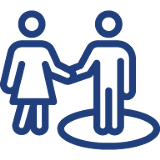
COUNTRY PROFILE
Discover more about the South Korea market including overviews about the retail, foodservice, and food-processing sectors. Events, resources, and more are linked throughout the profile.

$1.9 billion
U.S. processed food exports to Korea in 2022

6th
largest market for U.S. processed food exports

51.9 million
total population in 2023
Euromonitor International, a market research provider, reports that the South Korean economy slowed down in 2023 due to a deceleration in exports growth. With the inflation rate more than doubling, the government adopted a tighter monetary policy and provided energy subsidies to support vulnerable populations. Looking ahead, the global economic slowdown is set to further limit demand for South Korean exports, leading to deceleration in economic growth. Nevertheless, more cautious government spending is expected to result in a fiscal surplus in 2023. Focus Economics reports that South Korea’s (Korea) economy is heavily dependent on international trade, with exports accounting for close to half of Gross Domestic Policy (GDP). This makes the economy vulnerable to volatility in external demand and global trade flows. China and the U.S. are the country’s major trade partners.
South Korea’s population is rising slowly and amounted to 51.9 million in 2023 (CIA World Factbook Est.). Korea is the third most densely populated country in the world among countries with populations over 20 million. It is about the size of Indiana. Over 90% of Koreans live in urban areas covering only 17% of the country. Over half the population lives in the greater metropolitan Seoul area. Focus Economics reports that Korean society is aging rapidly, the fertility rate is currently the lowest in the world, and the population is declining. All three factors are weighing on private spending and putting pressure on fiscal resources, and they will do so increasingly in the coming years.
The country will add only about half a million more inhabitants between 2019 and 2030. The median age in 2023 was 45 years, significantly above the regional average and 10.7 years greater than the figure for 2000. Perhaps the most important population shift that is occurring is a large increase in the number of those over 65 years. In 2023, this group made up 18.3% of the total and will account for 25% by 2030. Long-run projections by the United Nations (UN) suggest that South Korea could have one of the oldest populations of any country in the world by 2050.
According to Trade.gov Korea has implemented 21 Free Trade Agreements with ASEAN, Australia, Cambodia, Canada, Central America (Partial), Chile, China, Colombia, European Free Trade Association (Norway, Switzerland, Iceland, and Liechtenstein), European Union, India, Indonesia, Israel, New Zealand, Peru, Regional Comprehensive Economic Partnership (RCEP), Singapore, U.K., U.S., Turkey, and Vietnam.
USDA’s Agricultural Trade Office (ATO) in Seoul, hereinafter referred to as “FAS Post Seoul,” reports that as the fifth largest country export market for U.S. agricultural exports, Korea provides a promising market for U.S. agricultural products. In 2022, Korea imported about US$50 billion agricultural and food products from all over the world, and the U.S. supplied a fifth of it, ranking number one. Other key suppliers were China, Australia, Brazil, Vietnam, and Thailand.
In 2023 Korea’s overall agricultural imports are forecast to fall short of the 2022 value by 10% partly due to decreased demand from both the retail and processing sectors. From January to October, the U.S. exports fell below the level of last year’s record for the same period, primarily driven by reductions in grain, feed, frozen beef, and dairy product exports. However, U.S. food and agricultural products will continue to be competitive in this market in the long run considering extended consumer interests in quality, safety, and sustainability.
Korea has dropped to the sixth largest market for U.S. processed food exports, now trailing the Philippines. U.S. exports totaled nearly US$2.5 billion in 2022, an increase of 3% over the previous year and an all-time record. In 2023, U.S. processed food exports to Korea drastically declined 23% to US$1.9 billion. That equates to a loss of nearly US$568 million, which adds to the U.S. trade deficit in food and agricultural products.
Top U.S. exports of processed foods in 2023 included:

$28.8 billion
expected retail sales in the packaged food market in Korea in 2023

$7.5 billion
imports of U.S. food and agricultural products in 2022

5th
largest packaged food market in the Asia Pacific region
According to Euromonitor, retail sales in the packaged food market in Korea had been estimated to reach US$28.8 billion in 2023. That represents an increase of 19.3% or US$4.6 billion since 2019. Korea is now the fifth largest packaged food market in the Asia Pacific region and is the 17th largest market in the world. By the year 2028, the retail sales in the packaged food market in Korea is expected to increase 11.4% to nearly US$34.4 billion, an increase of US$3.5 billion more than 2024.
High growth products in the forecast include:
FAS Post Seoul reports that driven by the development of Korea’s economy and evolving consumer preferences, the Korean retail industry has showed steady growths over the last 30 years. Growing consumer demand for quality, value and diversity have resulted in fast growth of modernized large-scale brick-and-mortar retailers, including hypermarkets, supermarkets, convenience stores, and on-line retailers at the cost of traditional street markets and small independent grocers.
Korean retail food sales totaled US$131 billion in 2022, accounting for 27% of total retail sales. Grocery supermarkets are the leading food retail channel, followed by online retailers, hypermarket discount stores, convenience stores, and department stores. Online retailers and convenience store food sales are expected to grow faster than other channels over the next five to 10 years. The fast expansion of on-line retailers is forcing conventional retail channels to restructure space and devise new strategies to attract consumer traffic.
An important trend to note is that Korean households are getting smaller. With fewer Koreans getting married and having kids, the country has the lowest birthrate in the world, reaching a new low of 0.78 in 2022. The total population of Korea was 51.9 million and the average number of family members per household was only 2.91. With smaller households, all the “adult” family members may be working outside, and people have less time to cook at home. Convenience becomes the key and markets for meal kits, ready-to-eat meals, and small-portion packaged food will grow steadily.
FAS Post Seoul reports that Korea imported US$7.5 billion of U.S. food and agricultural products in 2022, and Korea surpassed Japan as the top beef export destination and remained on top in 2023. Pork, seafood, tree nuts, distilled spirits, beer, condiments and sauces, potato chips, and sausages all enjoyed growth in 2023.

$131.7 billion
total sales of the HRI foodservice sector in 2022

54.8%
increase in 2021 guestroom sales

51.5%
increase in sales for food and beverage services
FAS Post Seoul reports that coping with the pandemic, Korea’s hotel, restaurant, and institutional (HRI) foodservice sector has tried to adopt modern technologies and developed strategies for safe and convenient dining experiences to meet changing demand from consumers. Since pandemic related restrictions have been lifted and consumer demand for diverse food and dining options is increasing, it is expected that the HRI sector will show a constant growth, though at a slow pace due to the sluggish local economy.
The pandemic has shaped the HRI sector and consumer behaviors in many ways. The staff shortages and social distancing restrictions forced eateries to leverage modern technologies by adopting online order and delivery systems and by installing self-order kiosks and server robots at their premises. As for consumer behavior, the pandemic fortified Korean consumers’ already-heightened awareness of safety and health aspects when choosing foods and dining options. The combined effect of this trend and Korean consumers’ general preference towards convenience and speed, coming from a busy lifestyle and the increasing number of small-scale households, has driven demand for contactless interaction in order, pick-up and delivery, and for diverse options of HMR (Home Meal Replacement) and RMR (Restaurant Meal Replacement) across the sector.
Business operators in Korea’s HRI foodservice sector tend to source imported food supplies through independent importers or intermediary distributors. Some large-scale operators work on expansion of direct imports to lower costs and to improve product assortments; however, their focus is mostly on a few high-volume products such as fresh fruit, meat, and seafood. Korea’s HRI foodservice sector is divided into three major subsectors based on the type of business and distribution channel: 1) hotels, 2) restaurants and bars, and 3) institutional foodservice.
Hotels have traditionally been a leading venue that highlights upscale and sophisticated menus to customers via their food and beverage services, and other players within the foodservice industry tend to use the new style and food ingredients introduced by hotels as a benchmark. This role of hotel was threatened during the pandemic as the overall hotel business was at risk, however, the industry managed to overcome the adversity by bringing in local travelers and by developing new strategies to attract customers to their food and beverage services.
According to data from the Korea Hotel Association, in 2021 guestroom sales rose by 54.8% compared to the previous year and by 0.55% from 2019. The number of customers and sales for food and beverage services went up as well by 31.3% and by 51.5%, respectively.
In 2021 (latest data available), total sales of the HRI foodservice sector reached 150.76 trillion KRW (US$131.7 billion), up 7.8% from 2020 and up 4.4% from 2019. Official statistics for more recent years are not available yet, but it is predicted that the sales figures have reached close to the pre-pandemic level as most eateries are fully back in business and consumer traffic is picking up.
In 2021, full-service restaurants, accounting for 55.8% of the HRI foodservice sector, demonstrated a sales increase of 7% compared to the previous year. Quick service restaurants, accounting for 21.8% of the sector, indicated an increase of 14.7%, and café and non-alcoholic beverage shops, accounting for 9.9%, showed the strongest growth of 19.9% compared to 2020. Institutional feeding and catering service grew by 9.6% and by 2.3%, respectively. The only sub-sector that recorded a sales decrease was bars, down by 21.8% in 2021 compared to the previous year. It is interpreted that people still used restaurants for dining-in or for takeaways and used cafes for quick stays but did not stay at bars as much in the evening due in part to the early closure mandate during the pandemic.
FAS Post Seoul reports that the imported products seeing strong growth in 2022 include potatoes, poultry meats, spirits, soup and broths, coffee, butter, mineral water, processed vegetables, and frozen beef.

$3.6 billion
in imports of basic and intermediate agricultural products from the U.S. in 2022

21%
of total imports of food and agricultural products in 2022 were from the U.S.

31,300 +
food processing companies as of 2021
FAS Post Seoul Korea reports Korea relies heavily on imports to fulfill its food and agricultural needs. The Korean food processing sector is the major user of imported agricultural products for processing use, including soybeans, wheat, vegetable oils, fruit juice concentrate, and food additives such as flavors, coloring agents, and preservatives.
Korea had over 31,300 food processing companies as of 2021, generating US$63.3 billion in sales. Korean food processing companies rely heavily on imported commodities and ingredients. Imports of basic and intermediate agricultural products totaled US$20.9 billion in 2022. US$3.6 billion or 17% of the total came from the U.S.
The Korean market reflects global food trends. The rise in single-person households and the increase in women’s participation in the workforce are influencing food purchasing patterns. Consumers want convenient and good value food products that suit their lifestyle. At the same time, consumers continue to seek healthier and higher quality food options.
The Home Meal Replacement (HMR) market has been growing since 2010. The HMR market is estimated to have reached 5 trillion KRW in 2022, more than doubled the size of the market in 2015 and was forecasted to expand further in 2023. Until recently HMRs were viewed as simple packaged products consumed by single-person households with busy lifestyles. Single-person households accounted for 33.4% of total households in 2021 and are expected to account for 35.6% of households by 2030. Small-portion HMR products have seen rapid growth due to this trend.
Despite challenges from competitors, the U.S. is expected to remain the leading supplier of food and agricultural products to Korea for years to come, not only for commodities and intermediate products, but also for consumer-oriented products. The United States accounted for 21% of total Korean imports of food and agricultural products in 2022.
FAS Post Seoul reports that products present in the Korean food processing market which have good sales potential in this sector include beef and pork fresh, chilled and frozen, edible offals, sausage casings, dried fruit, fish and seafood, spices, cheese and curd, tree nuts, wheat and meslin, soybeans and soybean oil, chocolate, food preparations, malt, and fruit juices including concentrates and extracts, and essences.

